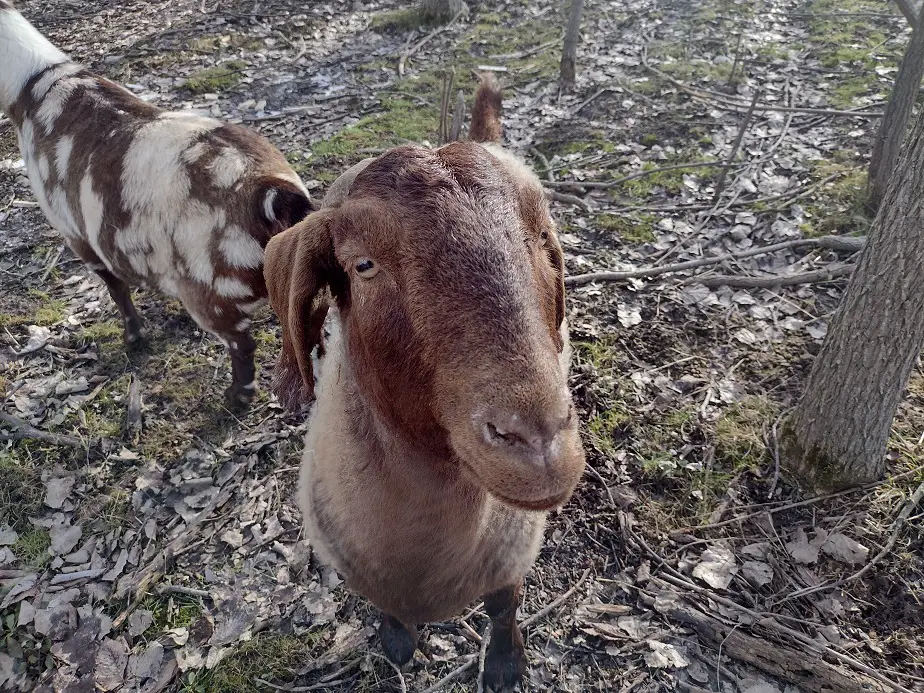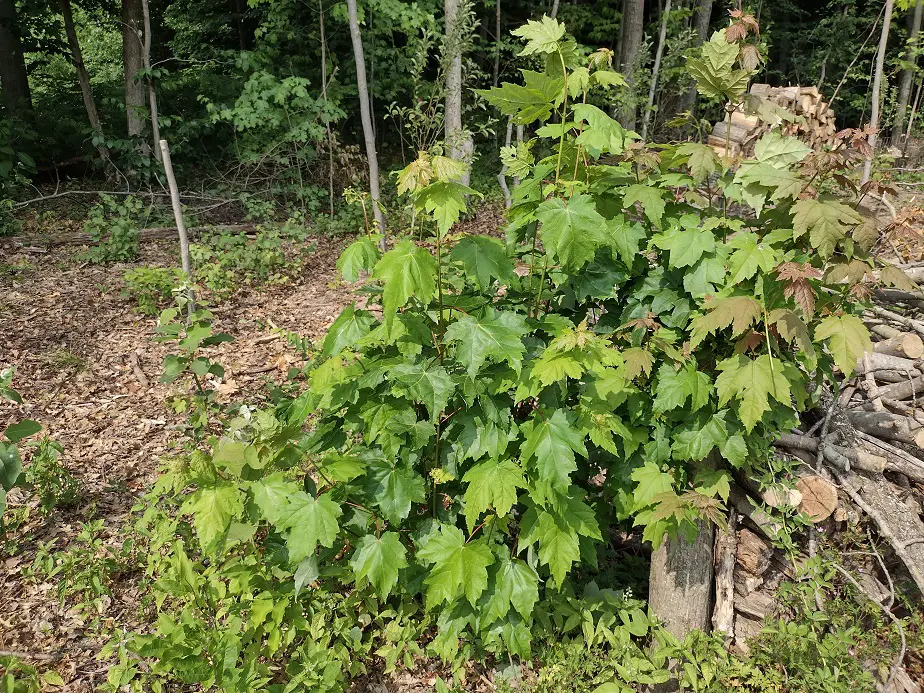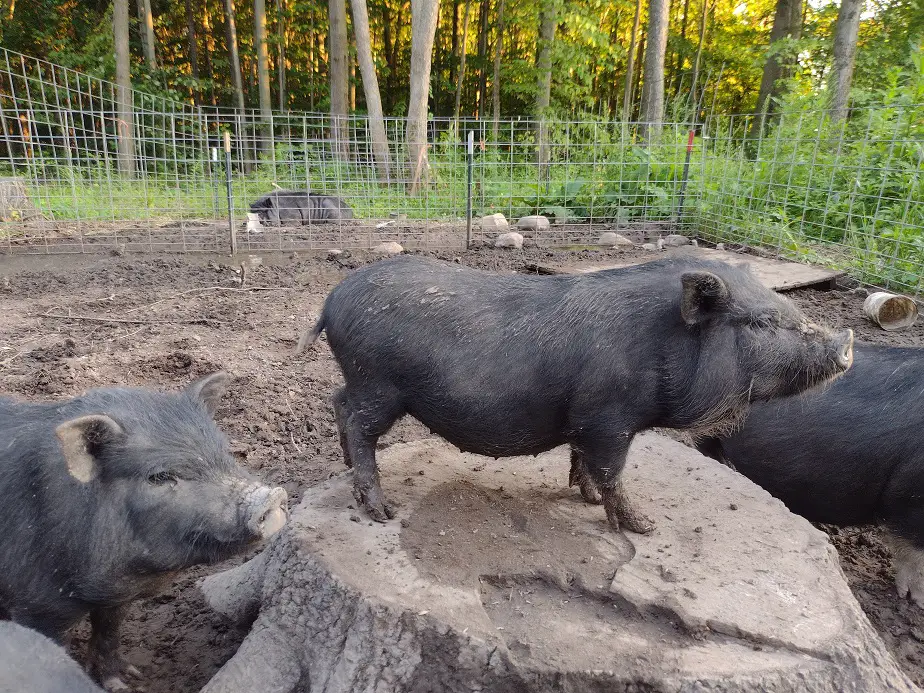We operate on a small property so I have to understand the more profitable animals.
Specialty Hogs
Specialty breed pigs are the most profitable livestock to raise per acre in my experience. I can produce $4.90 in revenue and $4.20 in income per square foot of land used with my pigs. I raise 250-ish up to 1 pound of pork per square foot, which sells directly for $5 a pound and costs less than a dollar a pound in feed.
I have yet to produce a system that can yield that good of results with anything else I’ve tried. Not saying it can’t be done, but I haven’t done it. Now, I will say that I’m not talking about anything remotely near the modern commercial hog business.
This year’s industry pork sales data reported a $36 average profit per head on a farrow-to-finish commercial farm. It’s even less if they are buying the piglets. Talk about unsustainable. Imagine raising a pig for seven months just for $36. That’s ridiculous honestly, and it encourages a bad system.
I’m talking about pigs like Mark Baker of Baker’s Green Acres raises. His prime Mangalista pigs are relished by discriminating customers and can demand $12 a pound. Butcher-ready pigs at my local livestock auction go for 75 cents a pound. So, why are my friend’s pigs so valuable?
It’s all in identifying the market for a specialty product that a lesser number of customers are willing to value highly. He raises a breed that’s renowned for producing premium pork but isn’t allowed in the large commercial industry. His pigs are more flavorful, more tender, and significantly more nutritious than common pork.
For info about different heritage breeds of pigs, read this article:
Heritage Hog Sizes, Butcher Weights, and Feed Requirements
They are raised outdoors, fattened on a pasture, and live a much more healthful and clean life. That’s a product that’s quite rare in this day and age. And, there are plenty of people looking to buy only clean, quality meat for their families.
I do it quite similarly. My pigs are bred and born on-farm, raised naturally by their mothers, and fattened on a pasture. They don’t get commercial hog feed, but get a special diet of starchy vegetables, tree fodder, pasture crops, orchard fruits, and pasture grasses.
It’s a feed combination that both ensures optimal health and cleanliness for the animal, but also assures a better flavor and quality of marbling in the pork.
Now, to be fair, I don’t always get exactly $4.20 in income per square foot. That’s not including the pens my breders are in. The breeders don’t take up nearly as much space as young, growing pigs. Let me get into a bit more detail for you.
I have only one acre. I raise Asian Heritage Hogs, which are a Potbelly/Kunekune cross. I could raise up to 50 of my feeder pigs on my 1-acre, and still have room for the sows and a boar or two. The way we feed our animals drastically cuts down on feed costs, so I guess I’m still around $4 a square foot of profit.
I know a guy, Carl Blake of Rustik Rooster Farm, who raises his own specialty mixed breed and sells them for $12/pound hanging weight, which comes to about $17 a pound plus processing for the finished product. I don’t quite know how, but he’s got plenty of business. It’s all in the marketing I guess.
For more info about pastured pigs, read this article:
9 Ways to Feed Pastured Pigs, (and keep them healthy)

Dairy Goats
Dairy goats can profit between $6 and $14 a day when they are being milked. Feed costs are usually around $2 a day, milk production per goat is 1-2 gallons a day, and it sells for $8-$16 dollars a gallon, depending on your area.
I’ve never done dairy, but my friends across town have a few dairy goats. Theirs are a mid-sized breed, Nubians. They are cherished for having some of the richest, creamiest milk available. And, let me tell you, it’s udderly amazing. Definitely a product in its own class.
We’re in a rural town and they sell it for $8 a gallon, raw. For a lot of people with trouble digesting milk, and people with dermatitis issues, raw milk is awesome. Also, because it’s goat milk, it’s type A2 milk, which means it’s even easier on the gut.
A2 is the name for a specific milk protein that was recently identified, and it’s now well-known to improve or eradicate milk intolerance and allergies, especially in children. Add to that that the milk is from animals on an all-natural, GMO-free diet and you have some valuable product.
If you can grow a decent amount of quality feed, like tree hay, It’s pretty easy to cut moat or all the feed bill out. But, that takes more land. Goats can be contained pretty easily with a really good electric fence or a nice, stout fence.
They can be a bit pricey to start with, and you have to have a plan to cycle out does that go dry and will need to be bred and birth again before they can come back into milk.
A friend of mine just told me that his friends up in Canada sell 90-pound meat goats for $400 each for meat. They sell them just before the Muslim holidays and time the breeding to that calenar. It’s certainly an option for some people to consider as well.
I have several great articles about raising goats. Here’s one great one.
How Many Goats Can I Raise Per Acre?

Meat Rabbits
Meat Rabbits are one of my favorite animals for profit. We raise Silver Fox rabbits, and they generally do decent to good. The animals themselves are quite productive, and one doe can have 4 litters of 6 to 12 bunnies a year. Each bunny, after growing decently, sells for around $20 pretty easily if you can find the market.
There’s apparently quite the market in some areas for whole, skinned rabbits as all-natural, raw dog food. That crowd is often willing to pay more than the folks who just want one for dinner.
It takes a month after breeding for a doe to give birth, and two or three months after for the rabbits to get to a decent butcher weight of around 5 pounds live, 2-1/2 pounds dressed. Whole, dressed rabbit commonly sells for between $5 and $10 a pound.
It takes approximately 54 square feet to house one breeding pair and raise out 4 litters a year. 4 litters of 8 bunnies sold for $7.50/pound grosses $600, or about $11 per square foot. Now, that’s only cage space so I’d probably add another 25 percent to account for a shelter to cover the cages.
Rabbits’ primary expense is usually housing, but a smart person can house them cheaply. Then feed becomes the most taxing expense. With a little space, it’s not hard to grow enough green fodder to feed a lot of rabbits. We feed a lot of tree hay to our rabbits.
Here’s a great place to start with meat rabbits: Cost to Raise Rabbits for Meat (complete guide)
Geese
Geese can net surprisingly high profits. They have very low feed costs if raised on a pasture because they are herbivores and thrive on grass. Raising geese on a small piece of pasture can definitely outperform other grazing animals. Goose eggs sell for $6-$10 a dozen, and an adult goose can sell for $30-$40.
Most goose farms sell their older geese every year for a nice, hefty profit. That’s what the guy from Gold Shaw Farm does. Geese are his most profitable livestock for the space they take up.
My wife worked on a goose farm for a summer internship program in high school. Apparently, she now hates geese so I can’t get any. Folks say they are way cleaner than ducks and much less destructive than chickens to the environment.
Ducks
Ducks can be a lucrative egg business. People who want duck eggs are generally willing to pay dearly and travel across town to get them. If you get into the right crowd, you will have an incredibly loyal customer base. Ducks lay far more eggs than geese, and they can sell for similar prices.
The main drawback with ducks is that they make a royal muddy mess and need fresh water constantly throughout the day. We had ducks early on. I’m not personally a fan. They are better egg layers than most chickens, but the eggs are usually very muddy and take a good scrubbing to get looking decent.
Personally, they’re not for me. In a different town with the right clientele, they probably would be.
Quail
Quail can be housed and raised in an incredibly small area, take a very short time to raise out, and sell for a premium price. They regularly go for $20-$25 a pound. That’s four average quail carcasses. Quail are the highest profiting animals per square foot that I know of.
The only struggle with quail is tapping into the very small marker for them. They’re easy and fast to raise and quick to butcher, but most people don’t want to eat quail. Still, there is a market for it, especially among a lot of high-end restaurants.
Specialty Dairy Cows
Heritage breed cows can have raw milk valued in excess of $10 dollars a gallon. Mark Baker sells his for, I think, $12 a gallon if I remember right. I should probably call him soon and chat about his prices. Similar to goats, many heritage breeds of cows have a much richer, A2 type milk.
A smaller breed like a Jersy will produce 4-6 gallons of milk a day. That’s up to $72 dollars in gross income. And, they generally have a 5 percent milkfat content. It’s amazing for making specialty cheeses, which would add a ton of extra value to the production.

With specialty dairy cows, the value of the milk and other products is already increased to the people who seek a more natural diet. Even a regular cow, if raised purely on pasture and hay, no grains, would be a specialty milk cow and have a higher value of product.
I can’t say I know much more about milk cows. I worked at a dairy farm as a teen, but haven’t dabbled in it since. I do know that a grass-fed cow produces less kilk, but at a far greater value and the result is greater profits, as long as you can tap into that market.
Related Articles:


